A DISUSED workers’ camp in the Top End that once housed thousands of people has somehow turned into Australia’s premier quarantine facility. How did this happen? How does it work? What goes on in there? Here’s everything you need to know.
BUILT on 60 hectares of land, the Howard Springs Quarantine Facility has housed nearly 3000 people during the pandemic, from those fleeing Victoria’s second wave of coronavirus to seasonal workers here from Vanuatu for the mango season.
The NT’s Deputy Chief Health Officer Professor Di Stephens has shed light on how the facility has become what it is today, what goes on in there for health workers and what its future plans are.
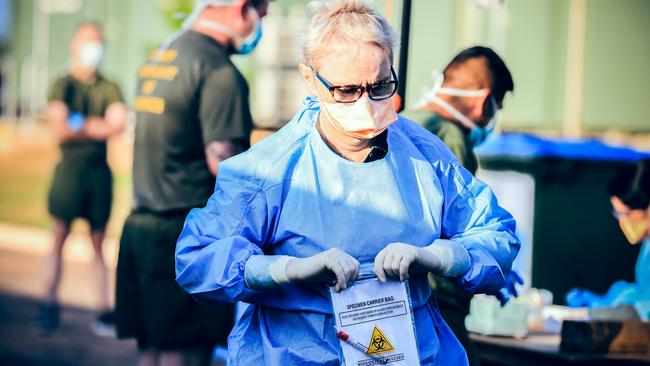
What is this place, exactly?
The Howard Springs Quarantine Facility, 30km southeast of Darwin, was originally built in 2012 by Japanese energy firm Inpex as a village to house 3,500 workers employed in the construction of its $55 billion gas plant on Darwin Harbour.
As Prof Stephens said, not much expense was spared on “one of the nicest workers villages in the country”, and the facility has everything from a pool, to movie theatres, a cafeteria hall and even a small GP clinic.
Once Inpex wrapped up construction in 2018, the facility was handed over to the NT government to figure out what they wanted to do with it.
Prof Stephens, in her dual role as medical director of the National Critical Care and Trauma Response Centre (NCCTRC) and the NT’s deputy CHO had scoped out the facility in January to see what it could be used for.
“It was clearly evident that this could be a potential site for housing the evacuees when we have floods during the wet season, so when we regularly evacuate Daly River, those kinds of circumstances where we put people in the showgrounds and other facilities that are not quite as purpose built, that this might actually be an option, albeit an expensive one,” she said.
At this time she had also been keeping a close eye on coronavirus and keeping a “watching brief” on possibly deploying health workers overseas to help.
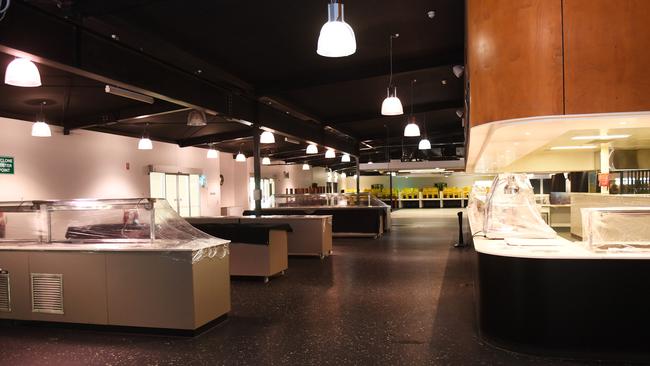
And t hen shit got real didn’t it?
Really quickly.
The Commonwealth decided to evacuate Australian’s from Wuhan, China, which was coronavirus ground zero and then passengers from the Diamond Princess cruise ship, which had been in Japan.
Capacity on Christmas Island was quickly overwhelmed, so authorities pivoted and said righto, Howard Springs it is.
The NCCTRC and the real life medical A-team known as AUSMAT, alongside multiple NT Government agencies including the Department of Infrastructure, Planning and Logistics and federal agencies like the Australian Defence Force, got their heads together and flipped the facility in three to four days in preparation for the arrivals.
“At that time there was very little knowledge about the virus and how it spread, what was the riskiest time and all of those things were unknown at that time in February when we had that first cohort,” Prof Stephens said.
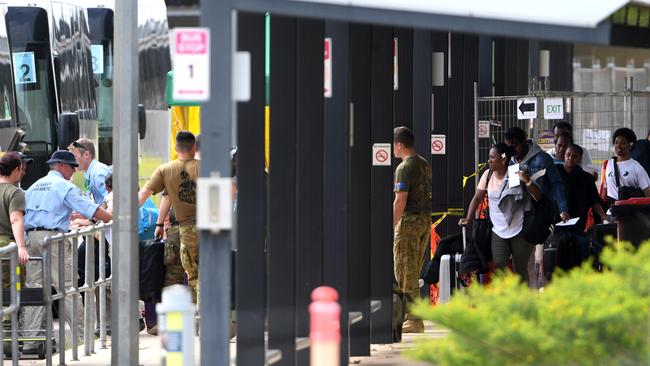
“And so everything was done in a very conservative fashion with the highest level of protection that we felt kept everybody safe. And that has been our philosophy going forward.”
Once those two cohorts left, the facility was shut down again but not for very long as authorities “quickly realised” that apart from the hotel quarantine and home quarantine set ups that the NT had in March that something else was needed for people “who couldn’t manage in the hotel setting or required additional assistance”.
On July 17 the NT’s border rules changed and anyone arriving from a declared hot spot, which at time of writing remains all of Victoria and about 30 local government areas in greater metropolitan Sydney, had to do two weeks at their own expense at Howard Springs or the facility in Alice Springs.
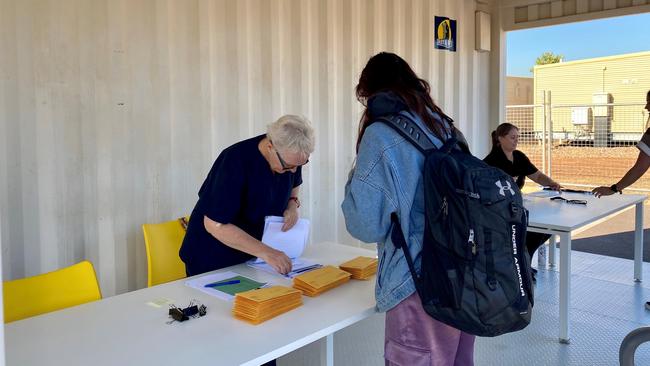
Quick brain break, give me the numbers
At time of writing Prof Stephens said approximately 1400 of the 3500 available rooms had been stood up.
As at September 19, 1022 people are in quarantine, though some will be at the facility in Alice Springs and the numbers are constantly changing as people leave and flights land.
The NT Government revealed in June that dusting off the Howard Springs facility cost $2.9 million. That doesn’t include staffing costs.
We know that the NT Government has also awarded a contract worth up to $24 million to Northern Rise Village Services Pty Ltd to provide services like cleaning, catering and grocery delivery.
There are about 300 staff, ranging from health and welfare workers to contractors to cops and security at the facility at any one time.
The total number of people who have tested positive for coronavirus in Howard Springs since July 17? Zero, as at September 19.
What makes this place so special?
It’s the only quarantine facility of its kind in Australia at the moment. Nowhere else do you get a balcony, the ability to leave your room to go into common areas, or get door knocked by nurses who come by on golf buggies to check if you’re okay.
Namely, it’s a health and welfare led system.
Prof Stephens said the NT “sets itself apart” by providing a “compassionate response” through its quarantine systems.
This includes, where it is safe and with strict conditions, allowing a “small number” of people to leave the facility to attend funerals or visit loved ones in palliative care.
“All along it’s been about community and people and everything we’ve done has been (through) the lens of, yes, we need to protect the community, but how can we do that in an empathetic and compassionate way,” she said.
“We now have people coming from Victoria to quarantine in Darwin so they can get to South Australia, New South Wales, Queensland and WA.
“To me, that’s sad, that they can’t go and quarantine at those places they need to go.”

“Everything we do is with the lens of is it safe, how can we make it safe? What are the risks, how can we mitigate the risk, and then put all of that in the context of being very compassionate, and making sure that people don’t have a bad experience during that two weeks,” she said.
“In many ways we need to support them with mental health and wellbeing activities and support to make sure that we’re … looking after people the right way.”
What does a typical day for a health worker look like at this place?
Assuming they’re on a standard shift as this place is staff 24/7, workers start at 8am and have a socially distanced team meeting where they go through the plan for the day — who’s leaving, how many people are coming in and so forth.
Health teams, in full PPE, take off on golf buggies across the facility and door knock every single person to see if they’re all right and swab those that need to be tested.
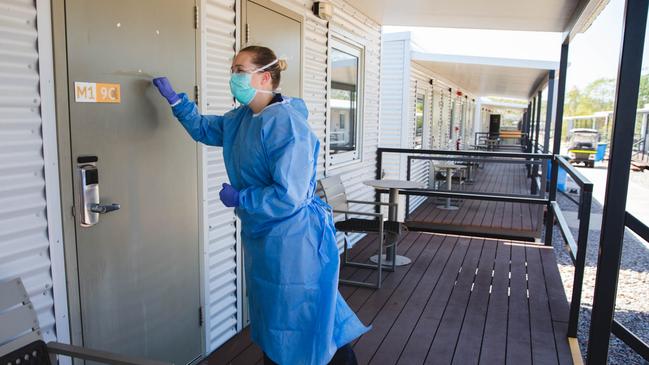
People get tested for COVID-19 within 24 hours of arriving and then again before they leave.
A lot of this stuff happens outdoors in the Territory heat and humidity so staff can duck into airconditioned “respite rooms” peppered throughout the facility to cool off.
Prof Stephens said everyone has lunch together, have a small debrief, before things start slowing down in the afternoon. That’s when all the exciting paperwork gets done.
There’s also a lot of pre-planning that goes on. At the moment it’s for the wet season and how they’ll navigate the rain.
Cyclone preparation is also on the books right now.
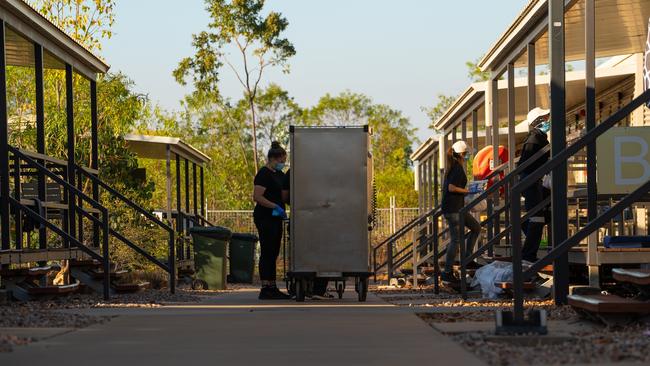
What are the rules in this dystopian tropical resort?
Residents are briefed on the rules as they arrive on the bus and mainly these are;
-No masks needed in your room or your balcony
-Masks at all times the moment you step away from those areas and physical distance at all times.
-The rules have been worked into the Chief Health Officer’s directions, so people who don’t follow them can be fined $5056. (No fines have been given out so far)
-No zooming about on kick scooters or similar (Prof Stephens said a kid had a bit of a tumble once so it was decided Howard Springs Quarantine Facility is not a place for zooming about on scooters)
LIMITED TIME: New NT News subscription offer: $1 a week for the first 12 weeks
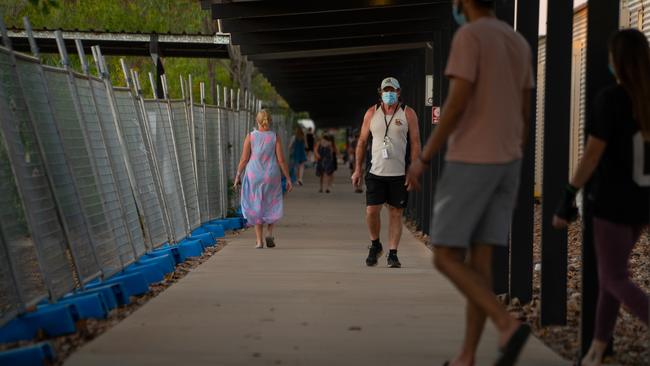
Mobile phone numbers are collected at the beginning of the stay so that “positive reinforcing messages” can be texted to them via the SMS system.
There’s also “in-house television stations” which are used to transmit health messages and welfare messages that emphasise mask wearing and physical distancing.
Overall Prof Stephens said people are really grateful to be there and don’t break the rules.
What’s going to happen to this place moving forward?
The Prime Minister, NT’s health Minister Natasha Fyles and Prof Stephens herself believe Howard Springs is a great facility to house Australian’s returning from overseas amid the pandemic.
There are a lot of logistics to be worked through however and it will take some time for that to happen, if it does.
Prof Stephens said no real thought had been put into what would happen post-coronavirus as it isn’t possible to “imagine a world beyond COVID-19 just yet”.
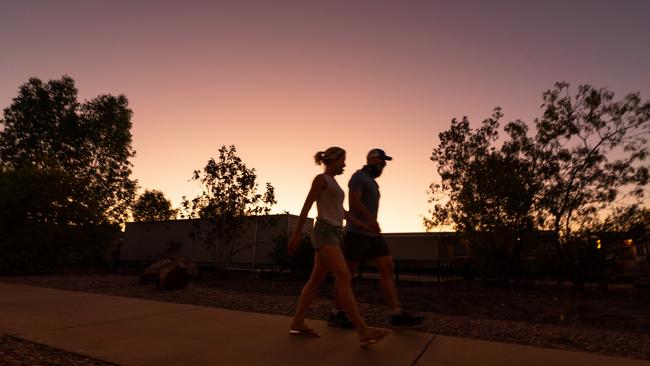

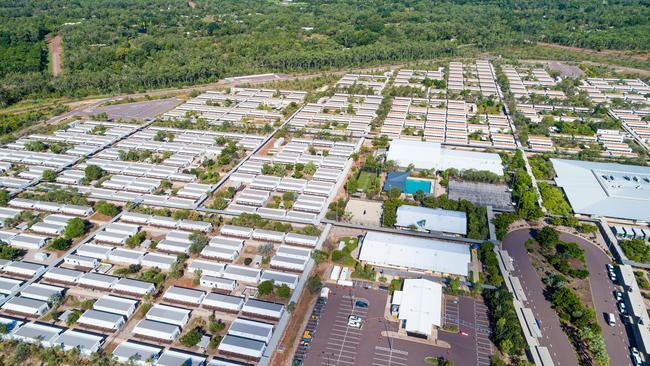
Add your comment to this story
To join the conversation, please log in. Don't have an account? Register
Join the conversation, you are commenting as Logout
Mental health advocate uses personal pain as strength
The award-winning mental health facilitator and advocate is passionate about breaking cycles of violence and is not afraid to use her own painful story to do it.
Unpacked: The Kumanjayi Walker coronial inquest findings
After almost three years since it began, the inquest into the death of Kumanjayi Walker has finished. So, what did Coroner Elisabeth Armitage find out – and will it bring change?